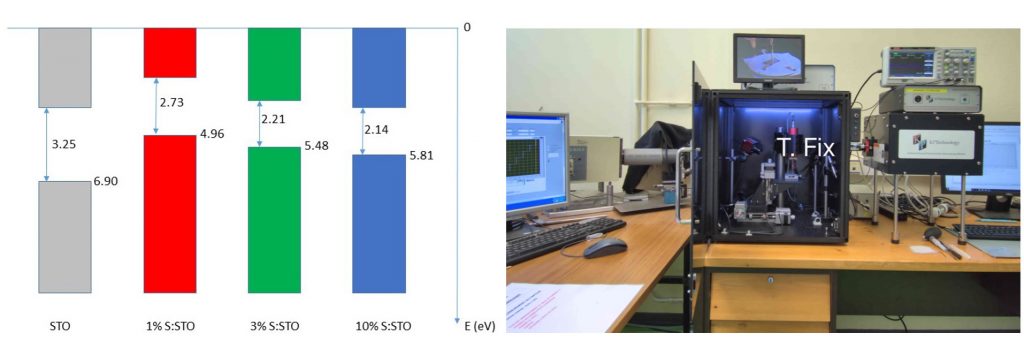Perovskites are based on the ABX3 formula. In halide perovskites, A is a monovalent organic or inorganic cation, B is an octahedrally coordinated divalent cation, and X is a monovalent halide such as Cl, Br, or I. Oxide perovskites also have the ABX3 formula with A and B cations but X is an oxygen atom, while in chalcogenide perovskites X can be sulfur or selenium. Recently, hybrid perovskites have emerged as a very important material as absorber for photovoltaics. Many researchers are into this field and there is rapid progress, even on the bottlenecks of stability and toxicity of such materials. At the same time, inorganic perovskite oxides for photovoltaics are progressing, encouraged by the progress from below 1% conversion efficiency to 8% efficiency with ferroelectric materials. Perovskite oxides are fascinating materials that span a broad range of exceptional properties such as superconductivity, magnetism, ferroelectricity, multiferroelectricity, 2D electron gases… Our research hypothesis is that while hybrid perovskites and oxide perovskites have been demonstrated to possess exceptional properties, there is much to expect from largely unexplored chalcogenide and oxysulfide perovskites as suggested by several studies [1-3]. The idea is to combine the high efficiency observed in halide perovskites with the high stability and versatility in oxide perovskites, in the form of novel chalcogenide or oxysulfide perovskites. So far we have investigated the possibility of growing CaTiS3 films by Pulsed Laser Deposition [4]. We also demonstrated a 1 eV bandgap reduction in SrTiO3 thanks to ion implantation of sulfur, confirming predictions on oxysulfide perovskites [5]. Finally we demonstrated a large Surface Photovoltage improvement in ferroelectric S:BiFeO3 [6].
[1] Are Chalcogenide Perovskites an Emerging Class of Semiconductors for Optoelectronic Properties and Solar Cell, A. Swarnkar, W. J. Mir, R. Chakraborty, M. Jagadeeswararao, T. Sheikh, and A. Nag, Chemistry of Materials 31, 565-575 (2019)
[2] Perovskite-inspired materials for photovoltaics and beyond – from design to devices, Y.-T. Huang, S. R. Kavanagh, D. O. Scanlon, A. Walsh, and R. L. Z. Hoye, Nanotechnology 32, 132004 (2021)
[3] The Role of Dimensionality on the Optoelectronic Properties of Oxide and Halide Perovskites, and their Halide Derivatives, R. Hoye*, J. Hidalgo, R. Jagt, J.-P. Correa-Baena, T. Fix*, J. MacManus-Driscoll*, Advanced Energy Materials 2100499, pages 1-59 (2021).
[4] Insights on CaTiS3 films grown by pulsed laser deposition, T. Fix, S. Raissi, D. Muller, C. Bouillet, D. Preziosi, A. Slaoui, Journal of Alloys and Compounds 964, 171272 (2023)
[5] Sensitive Bandgap Reduction of SrTiO3 through Incorporation of Sulfur Using Ion Implantation, T. Fix, Y. Zakaria, D. Stoeffler, D. Muller, A. Dinia, A. Slaoui, Solar RRL 8, 2400237 (2024)
[6] Effect of sulfur implantation in BiFeO3 thin films, T. Fix, X. Henning, D. Muller, R. A. Wibowo, M. Rastei, A. Dinia, A. Slaoui, Journal of Alloys and Compounds 1024, 180245 (2025)

